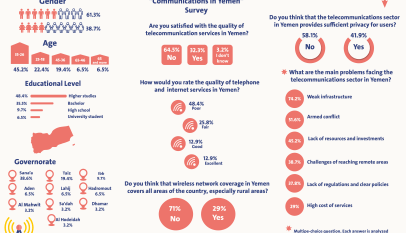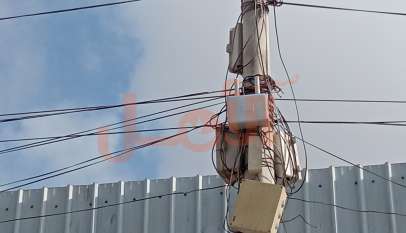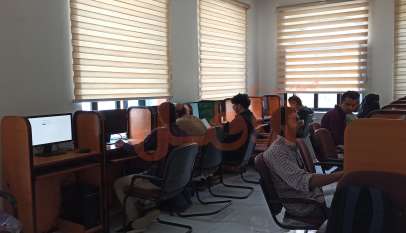Institutional Network Communication System Expands Scope, Achieves Leadership and Excellence
Sawt Al-Amal (Voice of Hope) – Alia Mohammed
Institutional communication is known as an administrative and social activity that contributes to the transfer and transformation of ideas through official channels within the organization. Its objective is to create cohesion within its units and achieve the organization’s goals.
In Yemen, the communication sector within institutes, universities, and Yemeni institutions is considered a fundamental element in ensuring communication and knowledge transfer. It plays a vital and decisive role in the success of their operations and activities.
Active Role
Munther Al-Haj, an employee in one of the companies, believes that the present time is an era of significant communication technology that helps us achieve success. He affirms that institutes, companies, and institutions currently rely on communication networks to carry out their daily operations, and no institution is without communication and connectivity services. The activities conducted by these institutions, institutes, and colleges vary. Some engage in industrial, productive, or service-related activities, while others combine multiple activities.
He adds, “The telecommunications sector facilitates internal and external communication for institutions through fast connectivity. It aids in the exchange of information and ideas between different departments and divisions within the organization. Additionally, it provides an opportunity to communicate with customers and respond promptly to their inquiries about the key services and activities offered by the institution.”
Al-Haj points out that communication technologies, such as Internet communication, email usage, and instant messaging, enable employees within the institution to organize work, collaborate on projects, and swiftly share documents and information. This contributes to improving efficiency, increasing productivity, reducing errors, and saving time and effort within institutions.
Expanding the Scope of Work
“The communication sector is a fundamental element for any activity in any company or institution,” emphasized Rashad Al-Faisal, Director of the Technical Production and Logistics Services Department. He further elaborated, stating, “The communication sector in institutes and universities differs from that in institutions and companies, depending on the activity carried out by the institution or center. The communications sector in institutions is divided into two departments: the first department communicates with customer service and involves communication with the client, while the second department is the network communication department through the Internet and technology.”
Regarding the overall goal and services provided by the telecommunications sector for the success of any company, Al-Faisal believes that the telecommunications sector plays a significant role in expanding the scope of work for institutions that are limited to a neighborhood, city, or region that utilizes Internet technology. It works to expand the scope of work in offering products and services on a broader level, ensuring faster access for customers.”
He adds, “Communication services are also important through classifying interested individuals and targeting them with marketing campaigns. Additionally, targeting the audience based on their different activities, specific age groups, gender, or geographic area through promotional emails, text messages, social media posts, and even creating websites to attract customers and achieve sales.”
Regarding the role played by the telecommunications sector in institutes and universities, Al-Faisal states that the role varies according to the ongoing activity, either through direct communication, fax, customer service, or hotlines.
He further states, “Network communication in institutes and universities works towards expanding the scope of work in all activities, whether commercial or educational, reaching a large number of the target audience in various specialties through the Internet and sponsored advertisements. This includes offering specialized courses, remote registration and fee payment, and obtaining statistics on the number of interested students in different specialties in the institute or university.”
He continues, “Universities and institutes use the telecommunications sector to establish virtual courses, rooms, or classes for distance education, and to establish electronic offices to provide services for students and facilitate access to information in integrated research centers through the website dedicated to the center or university via the Internet.” He emphasizes that all activities unite in serving direct communication, but they differ in the work policies of institutes, universities, and institutions.
Furthermore, Dr. Naji Al-Shaibani, Dean of the Faculty of Computer and Information Technology at Sana’a University, highlights the importance of communications in institutes and universities for communication and coordination between students and staff. He states, “Different communication methods such as email, phone calls, and text messages facilitate communication and coordination between students and staff. Students can communicate with faculty members and administration to ask questions, seek assistance, and staff can guide students and provide academic and administrative support more effectively.”
He emphasizes the possibility of publishing lectures and study materials online, which students can access and benefit from at any time and from any location, making it easier for them. Furthermore, communication methods can be used to organize academic, cultural, and social events and activities. He also points out that communication and social media platforms enhance collaboration between students and staff, enabling students to exchange ideas and experiences, support their development, and collaborate on research and academic projects.
Objectives of the Communication Sector in Institutions
The communication sector in institutions, institutes, and companies achieves multiple objectives. Communication is considered a fundamental means of exchanging ideas and disseminating information between leaders, subordinates, and all departments within the units. As a result, every member of the institution can access the organization’s data.
The presence of an effective communication system in institutions, in general, facilitates the flow of sufficient information between different departments. This contributes to helping top management make important decisions and convey them to the employees.
On the other hand, institutions and companies are interested in establishing an efficient communication system with their customers, who represent an important element in improving production and achieving profits. The continuity, growth, and sustainability of an institution depend on the public’s satisfaction with its efforts, which can only be achieved through an effective communication system that listens to the public’s opinions, customers’ feedback, and suggestions, as well as addressing their complaints to improve production or services.
General Difficulties
Despite the importance of communications, there are difficulties and challenges facing Yemen. In general, the communication sector suffers from challenging economic conditions that have hindered the improvement of the communication infrastructure.
In this context, Al-Shaibani highlighted the important difficulties and challenges that institutions, institutes, universities, and companies face in the communication process. He said, “Some institutions and centers face challenges in providing the necessary technologies for effective communication, such as high-speed Internet. This affects the ability of students and employees to access digital resources and communicate easily.”
He added, “Students and employees may face difficulties in using modern technology and communication tools, which affects the effectiveness of communication due to a lack of necessary training in utilizing those tools. Communications in Yemen have been affected by the conflict, and the political and security situations in the country have led to frequent disruptions in communication services, negatively impacting general communication. In addition to that, there are no clear and effective laws serving the sector.”
Referring to the solutions and steps that the communication sector can take to fulfill its role in achieving success for institutions, universities, institutes, and companies, he emphasized the following: improving the communication infrastructure, providing training and technical support for students and employees, and equipping them to keep up with the latest technological advancements.
He continued, saying, “It is also necessary to enhance technical awareness and provide instant translation when needed. Additionally, exchanging experiences and sharing knowledge, establishing partnerships with international organizations, and signing agreements to enhance this sector and establish training programs and develop specialized academic programs in the field of communications and information technology.”
The communication sector remains one of the most important sectors for the success of institutional operations and enabling internal and external communication, aiming to improve efficiency and achieve leadership and excellence in the competitive market. Institutions must allocate their efforts to the development and advancement of the communication sector, employing the latest technologies and tools to achieve their goals and meet their needs.
74.2% of Respondents in the Survey See the Lack of Infrastructure as One of the Most Prominent Problems Facing the Telecommunications Sector in Yemen
Sawt Al-Amal (Voice of Hope) – Yomna Ahmed The telecommunications sector is one of the mo…












